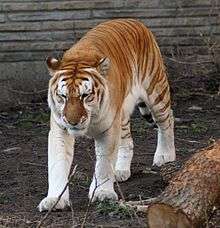Golden tiger

A golden tiger, golden tabby tiger or strawberry tiger is a tiger with a color variation caused by a recessive gene. The coloration is a result of captive breeding and does not occur in the wild. Like the white tiger, it is a color form and not a separate species.
No official name has been designated for the colour. It is sometimes referred to as the strawberry tiger due to the strawberry blonde coloration. Their striping is much paler than usual and may fade into spots or large prominent patches. Golden tigers also tend to be larger and, due to the effect of the gene on the hair shaft, have softer fur than their orange relatives.
Golden tigers in zoos

Few zoos have bred or exhibited golden tigers and many have no knowledge of the color or its mode of inheritance. It therefore usually appears by accident when breeding orange and white tigers together, rather than through planning. As white tigers and heterozygous normal colored tigers carrying the wide band gene are traded and loaned between zoos and circuses for breeding, that gene becomes more widespread. When their descendants are mated together, the golden tiger color is passed on to the offspring if both parents are gene carriers. Unless golden tabby cubs are born, the zoos may have no idea that the parents carry that gene.
The first golden tiger cub born in captivity was in 1983 and this came from standard-colored Bengal tigers, both of whom carried the recessive genes for both the golden tiger and white colors. It was born at Dr. Josip Marcan's Adriatic Animal Attractions in DeLand, Florida.
Australia
An example of a golden tiger is in Dream World in Australia. Samara, a normal orange tigress, had been mated with nearly-stripeless white male tiger, Mohan. Her litter included one normal orange cub (Sultan), the first white tiger born in Australia (Taj, also nearly stripeless), and the first two tabby-colored tigers (male Rama and female Sita) born in Australia. The cubs weighed around 1.5 kilograms and measured approximately 30 centimetres in length. They were removed from their mother soon after birth and hand raised. The births and hand-raising process were filmed and presented in an hour long documentary. Golden tabby Sita will be mated to an unrelated normal orange tiger called Kato.
Europe
Diamond, a male golden tiger, is housed at the Isle of Wight Zoo in the UK. Because he is inseparable from his normal coloured sister, who also carries the golden gene, Diamond was castrated to prevent inbreeding, although due to his sister being a heterozygous carrier for the gene, there is a chance that any offspring may express the gene in their phenotype. Glasgow Zoo's golden tiger, Butu, obtained from Longleat, went to Germany when Glasgow Zoo closed. Longleat in the UK previously had an elderly golden tiger named Sonar, but he died in 2006. In Autumn 2010, a golden tabby tiger, Shami, was born in a zoo in ZOOPARK in Næstved, Denmark. It's the first of its kind to be born in Scandinavia, and only the third in Europe. In May 2012, two more golden tabby tigers were born at the ZOOPARK.
The Olmense Zoo in Belgium also has a golden tiger.
North America
The following North American locations have (or had) golden tigers.
- Serenity Springs Wildlife Center in Calhan, Colorado owns a young golden tabby tiger named "Khaleesi."
- St. Augustine Wild Reserve, a big cat sanctuary in North Florida, owns a young, female golden tabby named "Sitarra."
- Six Flags Great Adventure in Jackson, New Jersey has two: A male, Kingda Ka, who has a roller coaster named after him, and his half-sister Raina. These tigers are part of the family that appears in daily educational award-winning shows about these specific tigers. T.I.G.E.R.S., which performs at King Richard's Faire in Carver, Massachusetts and elsewhere, also has golden tabby tigers.
- One of T.I.G.E.R.S.'s golden tabby tigers, Ramu, is on loan to the Dakota Zoo in Bismarck, North Dakota. There is a 3 month old Golden Tabby tiger cub at T.I.G.E.R.S Preserve, Myrtle Beach, South Carolina, as of May 2013.
- Taj, resides at the Cougar Mountain Zoo in Issaquah, WA.
- Another golden tabby can be found at the Buffalo Zoo.
- Topaz is a permanent resident at The Catty Shack Ranch, a wildlife sanctuary, in Jacksonville, FL.
- A female named Shammi can be found at GW Zoo in Wynnewood, Oklahoma.
- There are three tabby tigers found at Miami's Jungle Island.
- There are four tabbies in the Dallas-Fort Worth Area - Arula, Kumari, & Kahil at Tiger Creek Wildlife Refuge (Tyler, Texas)
- Tyjar is at In-Sync Exotics Wildlife Rescue Center (Wylie, Texas)[1]
- The Exotic Feline Center in Center Point, Indiana has a golden tabby tiger named Sahib.[2]
- Zoosiana in Broussard, Louisiana has two golden Bengal tiger cubs named Filé and Gumbo.[3]
- There is a tabby tiger cub at Zootastic Park of Lake Norman in Troutman, North Carolina, as of January 2016.
- There are two tabby tiger sisters, Shiva and Kali, at Tiger World in Rockwell, North Carolina. [4]
Asia
A young golden tabby named as "Mish Mish" is found in Ras Al Khaimah wildlife Park, Ras Al Khaimah, United Arab Emirates, owned by Mr Jasem Ali.
Though golden tabby tigers are not deliberately bred for by conservation-minded zoos, they have joined the white tiger in becoming popular for use in stage shows and similar events. A few private breeders are attempting to produce golden tabby tigers alongside white tigers to meet the demand.
The Lyger Animal Sanctuary owned by Mario de Santos in Pililla, Rizal, Philippines recently bred two golden tabby tigers last July 2016.
Golden tigers in the wild
India has records of wild golden tigers which date back as far as the early 1900s. The unusual color would provide these tigers with extra camouflage. The theory remains unproven; inbreeding of a small isolated group of tigers could cause the recessive golden tiger gene to emerge if at least one of those tigers carried the recessive gene for the golden color and bred with its own offspring.
Golden tigers may occur in the same litter as all orange color and the white color, respectively. The wide band mutation is not found solely in white tigers and may also be carried by normal colored tigers; however, carriers of the wide band gene are probably no longer found. The last known wild golden tigers were observed in the early 20th century.
Wild-born golden tigers might be disadvantaged as they are less well camouflaged than normal orange or red tigers.
Golden tiger genetics
All golden tabby tigers seem traceable to a white tiger called Bhim, a white son of a part-white Amur tiger named Tony. Tony is considered to be a common ancestor of all white tigers in North America. Bhim was a carrier of the wide band gene and transmitted this to some of his offspring. Bhim was bred to his sister Sumita (also a carrier of the wide band gene), giving rise to stripeless white tigers (i.e. having two copies of the wide band gene). Bhim was also bred to a normal orange tigress called Kimanthi, and then to his own orange daughter Indira from that mating. The mating of Bhim and Indira resulted in striped white, stripeless white, normal orange, and golden tabby offspring indicating that both Bhim and his daughter carried the wide band gene. When the golden tabby male offspring was mated to the normal orange female offspring, both golden tabby tigers and white tigers resulted.
Litters of different colored cubs are not unusual because the white and golden tabby colours are caused by combinations of hidden recessive genes carried by the parents. White tigers, such as Dreamworld's Mohan (named after the white tiger captured in India in the 1950s), are highly inbred. Inbreeding reduces genetic variability and may cause hidden genes to manifest as there is a greater probability that two recessive genes will meet up.
Analysis of golden tiger family trees shows that golden tigers are genetically normal orange coloured tigers with the addition of a recessive modifying gene, probably the wide band gene. This same wide band gene also gives rise to stripeless white tigers. A white tiger that inherits two copies of the recessive wide band gene will be a stripeless white. A normal orange tiger that inherits two copies of the recessive wide band gene will be a golden tabby. The wide band gene is carried independently of the white gene.
See also
References
- ↑ http://www.insyncexotics.com/Tyjar.html
- ↑ Exotic Feline Center. "November 2010 Cat Tales Newsletter" (PDF). Exotic Feline Center. Retrieved 14 March 2011.
- ↑ http://www.iberianet.com/news/mischievous-tigers/article_60b0e090-2376-11e2-8eb4-0019bb2963f4.html
- ↑ http://www.tigerworld.us/tiger-world-animals/
External links
| Wikimedia Commons has media related to Golden tigers. |